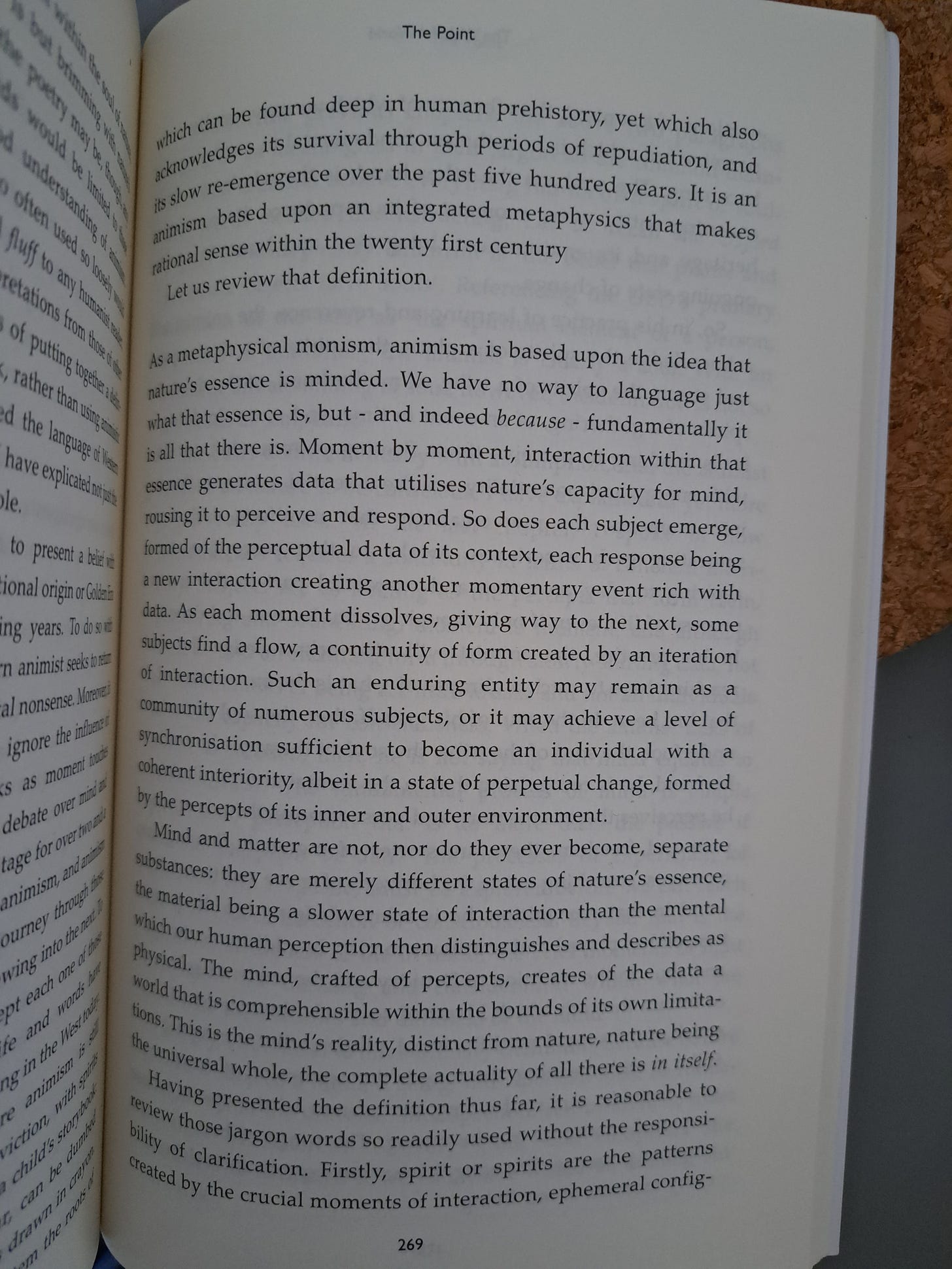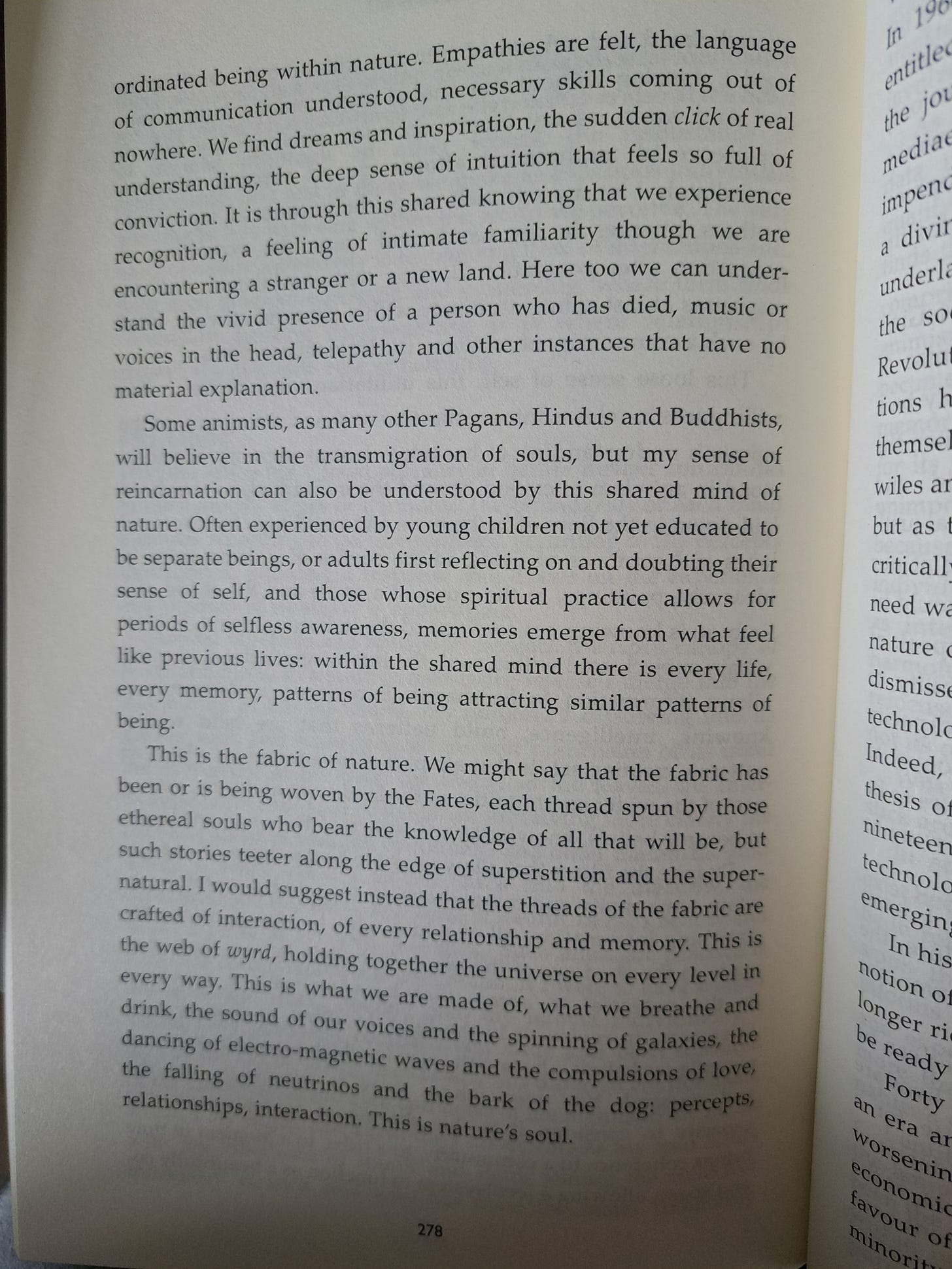
Discover more from Vitalist Essays

Now that’s one of the best non-fiction books I’ve read in a long time. Well-written and well-researched, it opened to me the world of animist writers and POVs.
The Wakeful World. Animism, Mind and the Self in Nature by Emma Restall Orr. The author is a reknowed writer coming from a practical angle, and very active in the Druidism tradition.
Chapters of the book:
The Enquiry
Spirit
Matter
Integration
Moments
Interaction
The Self
Consciousness
The Point
The book starts with an examination of extant approaches (chapters 1-5). The animistic ontology is built ground up, similar to Cartesian or Early Wittgenstainian approaches.
Animist Position tl;dr
to the animist, a state of permanent enlightenment is not considered natural (p. 99)
Nature is seen not as an inert matter waiting for Man or Logos to make it come to life. The Orrian Animist sees a darkness in reality, but a reality that is a unity.
animism is a monist metaphysical stance, based upon the idea that mind and matter are not distinct and separate substances but an integrated reality, rooted in nature (p.104)
That view carries on the Aristotelian tradition of seeing soul as perishable. Of course, anthropomorphization of objects is avoided
we have tripped again into philosophy written in crayons, imagining rivers and trees that think and speak in human tongues, and primitive folk who believe such things to be true (p. 107)
Animist Lineage
A wonderful lineage of animizing thinkers is traced, among great figures of philosophy and literature:
Prospero in Shakespeare’s the Tempest
we deem the whole world animate, and all globes, all stars, and this glorious earth
But also John Milton and Leibniz (1714 Monadology)
every being in the universe from living animals down to the simple monad was alive or composed of living parts, there being nothing fallow, sterile or dead in the universe; no chaos, no confusion, save in appearance
Also later authors like Diderot, Keats and 20th century writers: Huxley, de Chardin.
Facets of life through animist lens
How is death approached under this POV?
in the poetry of animism, it is said that the deceased lives on in the wind and the waters of their landscape, in the poetry and songs of the trees and the birds, in the heart and mind of their community (p.225)
Chapter 8 is all about consciousness. The introduction to it contains a very relatable sentence
as is often the way with my writing, I set myself the task of writing the book for which I myself had long been searching, the book I had hoped someone else had already written (p. 228)
Consciousness here is said to be inside-the-world, partaking in it. The world is not rejected.
a principle of animism that is worth stressing once again: there is no depreciation of physicality. The physical world is not at the dirty bottom of some scala naturae, nor is it an illusion to be shrugged off with enlightenment: it is as much what we are as the subtler patterns of mind (p. 234)
This theme is continued, that we’re looking at the universe from the outside or inside:
seamless universe, of which we are an integral part, which can be known in two fundamentally different ways. At the interface of consciousness and brain, it can be known in terms of how it appears (from the outside) and in terms of what it is like to be that universe(from the inside). ( p. 236)
Many prominent authors are quoted throughout, weaving a network of references in animist spirit throughout the pages of the ages:
Parerga and Paralipomena - > the world and only a physical and not a moral significance is a fundamental error, one that is the greatest and most pernicious, the repeal perversity of the mind (citation put on page 267)
Do you need a god who can dance? The animist experience is omnipresent
in the dark and noise of the nightclub the music shatters my edges, and again the I disappears as my souls melds with the vibrations of sounds and light, joining the collective movement of each soul who has done the same, voluntarily overwhelmed and subsumed into the tribal mind - until some rigid I, dancing without this shared synchronicity, bumps into me! (p. 277)
Unlike many mostly theoretical philosophies, this approach changes everyday experience quite like Buddhism does.
Finally the practical approach to life is very low-key, something I quite relate to:
https://twitter.com/doxometrist/status/1643334118778839046
Author quotes Colin McGinn: “ too much meaning in life can be a burden; insignificance can lighten the heart”.
That’s the end of the review, I recommend it to anyone interested in an overview of the pagan philosophy.
Next upcoming review is for The Earth, The Gods and The Soul. A history of Pagan Philosophy from the Iron Age to the 21st Century by Brendan Myers
Appendix - photos of some of the most interesting pages referenced above
Quite e/acc, isn’t it?
Extremely left hand path, no?












